FIAT BRAVO 2013 2.G Owners Manual
Manufacturer: FIAT, Model Year: 2013, Model line: BRAVO, Model: FIAT BRAVO 2013 2.GPages: 299, PDF Size: 5.86 MB
Page 191 of 299
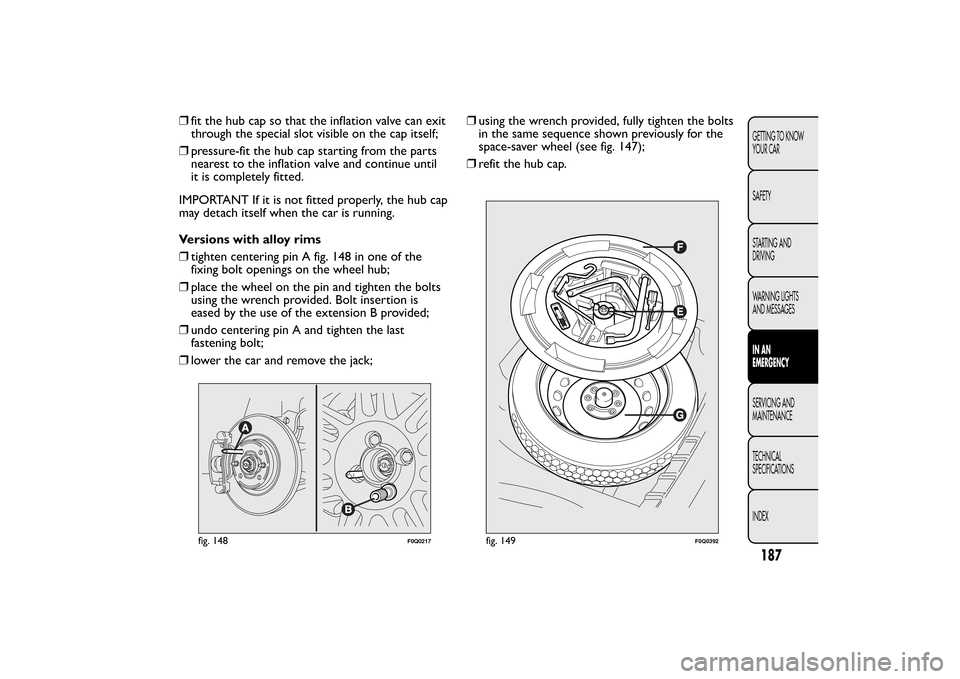
❒fit the hub cap so that the inflation valve can exit
through the special slot visible on the cap itself;
❒pressure-fit the hub cap starting from the parts
nearest to the inflation valve and continue until
it is completely fitted.
IMPORTANT If it is not fitted properly, the hub cap
may detach itself when the car is running.
Versions with alloy rims
❒tighten centering pin A fig. 148 in one of the
fixing bolt openings on the wheel hub;
❒place the wheel on the pin and tighten the bolts
using the wrench provided. Bolt insertion is
eased by the use of the extension B provided;
❒undo centering pin A and tighten the last
fastening bolt;
❒lower the car and remove the jack;❒using the wrench provided, fully tighten the bolts
in the same sequence shown previously for the
space-saver wheel (see fig. 147);
❒refit the hub cap.
fig. 148
F0Q0217
fig. 149
F0Q0392
187GETTING TO KNOW
YOUR CAR
SAFETY
STARTING AND
DRIVING
WARNING LIGHTS
AND MESSAGESIN AN
EMERGENCYSERVICING AND
MAINTENANCE
TECHNICAL
SPECIFICATIONS
INDEX
Page 192 of 299
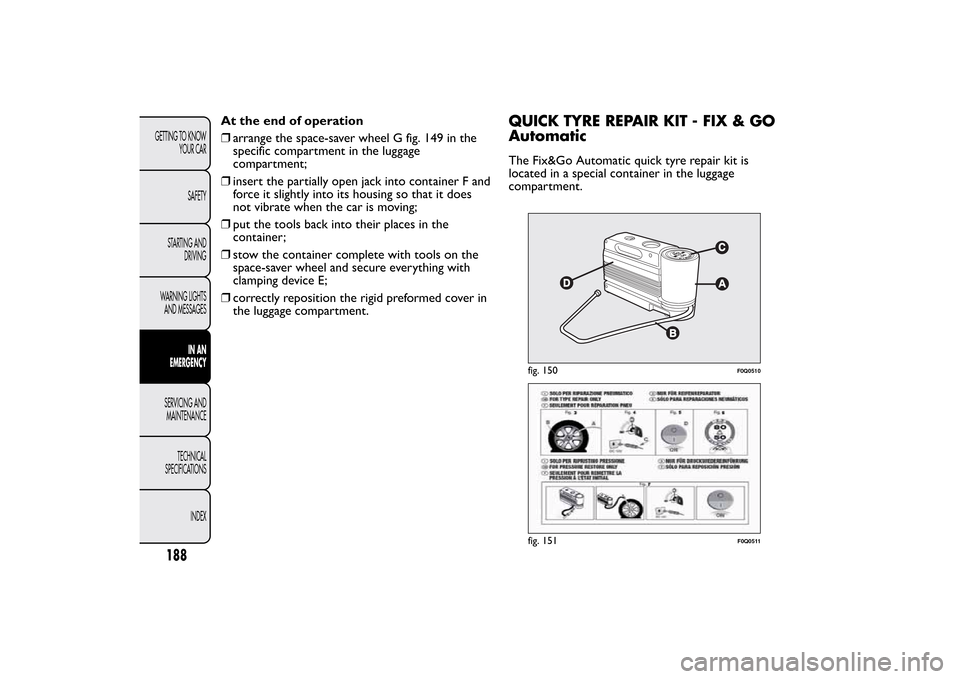
At the end of operation
❒arrange the space-saver wheel G fig. 149 in the
specific compartment in the luggage
compartment;
❒insert the partially open jack into container F and
force it slightly into its housing so that it does
not vibrate when the car is moving;
❒put the tools back into their places in the
container;
❒stow the container complete with tools on the
space-saver wheel and secure everything with
clamping device E;
❒correctly reposition the rigid preformed cover in
the luggage compartment.
QUICK TYRE REPAIR KIT - FIX & GO
AutomaticThe Fix&Go Automatic quick tyre repair kit is
located in a special container in the luggage
compartment.
fig. 150
F0Q0510
fig. 151
F0Q0511
188GETTING TO KNOW
YOUR CAR
SAFETY
STARTING AND
DRIVING
WARNING LIGHTS
AND MESSAGES
IN AN
EMERGENCY
SERVICING AND
MAINTENANCE
TECHNICAL
SPECIFICATIONS
INDEX
Page 193 of 299
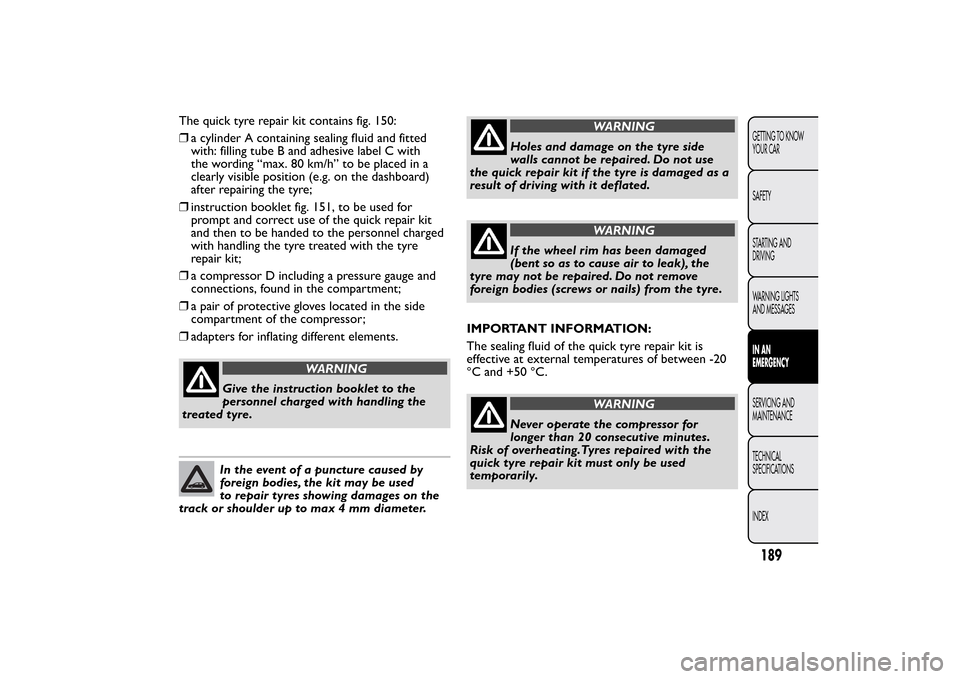
The quick tyre repair kit contains fig. 150:
❒a cylinder A containing sealing fluid and fitted
with: filling tube B and adhesive label C with
the wording “max. 80 km/h” to be placed in a
clearly visible position (e.g. on the dashboard)
after repairing the tyre;
❒instruction booklet fig. 151, to be used for
prompt and correct use of the quick repair kit
and then to be handed to the personnel charged
with handling the tyre treated with the tyre
repair kit;
❒a compressor D including a pressure gauge and
connections, found in the compartment;
❒a pair of protective gloves located in the side
compartment of the compressor;
❒adapters for inflating different elements.
WARNING
Give the instruction booklet to the
personnel charged with handling the
treated tyre.In the event of a puncture caused by
foreign bodies, the kit may be used
to repair tyres showing damages on the
track or shoulder up to max 4 mm diameter.
WARNING
Holes and damage on the tyre side
walls cannot be repaired. Do not use
the quick repair kit if the tyre is damaged as a
result of driving with it deflated.
WARNING
If the wheel rim has been damaged
(bent so as to cause air to leak), the
tyre may not be repaired. Do not remove
foreign bodies (screws or nails) from the tyre.
IMPORTANT INFORMATION:
The sealing fluid of the quick tyre repair kit is
effective at external temperatures of between -20
°C and +50 °C.
WARNING
Never operate the compressor for
longer than 20 consecutive minutes.
Risk of overheating.Tyres repaired with the
quick tyre repair kit must only be used
temporarily.
189GETTING TO KNOW
YOUR CAR
SAFETY
STARTING AND
DRIVING
WARNING LIGHTS
AND MESSAGESIN AN
EMERGENCYSERVICING AND
MAINTENANCE
TECHNICAL
SPECIFICATIONS
INDEX
Page 194 of 299
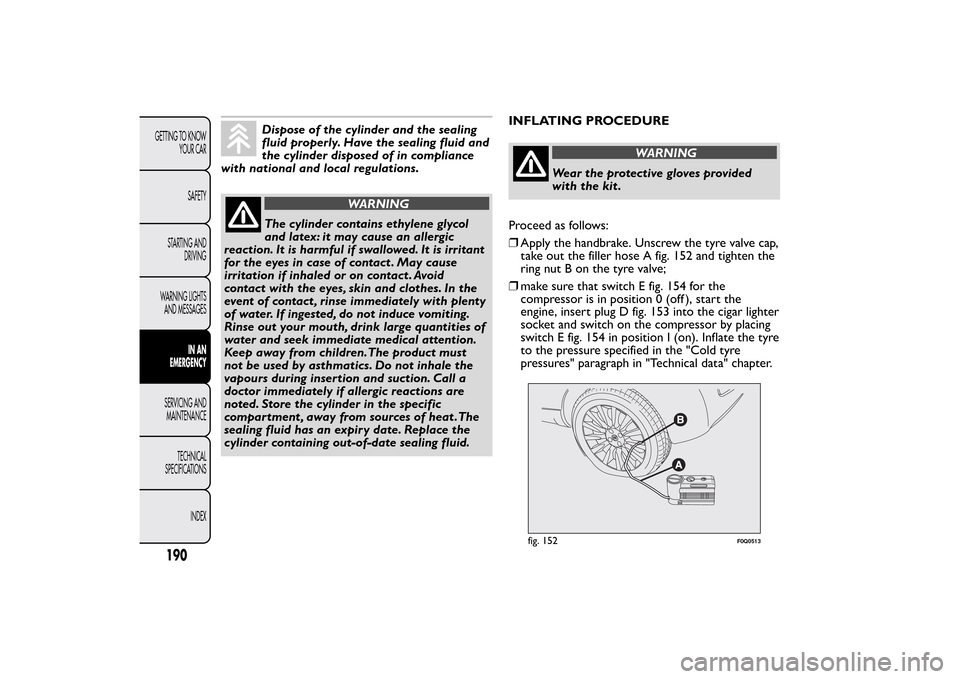
Dispose of the cylinder and the sealing
fluid properly. Have the sealing fluid and
the cylinder disposed of in compliance
with national and local regulations.
WARNING
The cylinder contains ethylene glycol
and latex: it may cause an allergic
reaction. It is harmful if swallowed. It is irritant
for the eyes in case of contact . May cause
irritation if inhaled or on contact . Avoid
contact with the eyes, skin and clothes. In the
event of contact , rinse immediately with plenty
of water. If ingested, do not induce vomiting.
Rinse out your mouth, drink large quantities of
water and seek immediate medical attention.
Keep away from children.The product must
not be used by asthmatics. Do not inhale the
vapours during insertion and suction. Call a
doctor immediately if allergic reactions are
noted. Store the cylinder in the specific
compartment , away from sources of heat .The
sealing fluid has an expiry date. Replace the
cylinder containing out-of-date sealing fluid.INFLATING PROCEDURE
WARNING
Wear the protective gloves provided
with the kit.
Proceed as follows:
❒Apply the handbrake. Unscrew the tyre valve cap,
take out the filler hose A fig. 152 and tighten the
ring nut B on the tyre valve;
❒make sure that switch E fig. 154 for the
compressor is in position 0 (off ), start the
engine, insert plug D fig. 153 into the cigar lighter
socket and switch on the compressor by placing
switch E fig. 154 in position I (on). Inflate the tyre
to the pressure specified in the "Cold tyre
pressures" paragraph in "Technical data" chapter.
fig. 152
F0Q0513
190GETTING TO KNOW
YOUR CAR
SAFETY
STARTING AND
DRIVING
WARNING LIGHTS
AND MESSAGES
IN AN
EMERGENCY
SERVICING AND
MAINTENANCE
TECHNICAL
SPECIFICATIONS
INDEX
Page 195 of 299
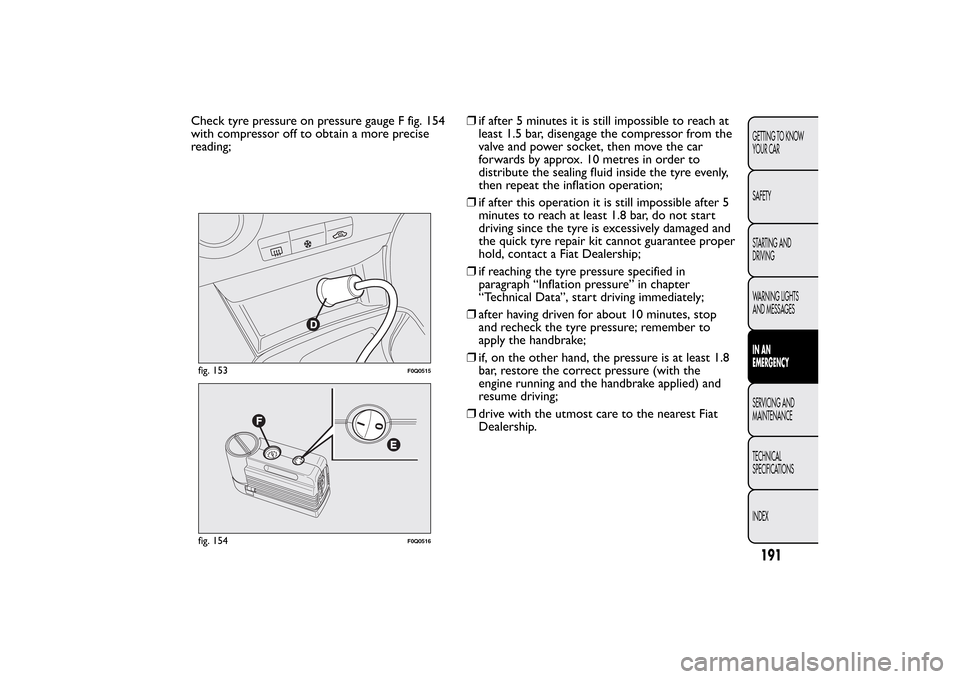
Check tyre pressure on pressure gauge F fig. 154
with compressor off to obtain a more precise
reading;❒if after 5 minutes it is still impossible to reach at
least 1.5 bar, disengage the compressor from the
valve and power socket, then move the car
forwards by approx. 10 metres in order to
distribute the sealing fluid inside the tyre evenly,
then repeat the inflation operation;
❒if after this operation it is still impossible after 5
minutes to reach at least 1.8 bar, do not start
driving since the tyre is excessively damaged and
the quick tyre repair kit cannot guarantee proper
hold, contact a Fiat Dealership;
❒if reaching the tyre pressure specified in
paragraph “Inflation pressure” in chapter
“Technical Data”, start driving immediately;
❒after having driven for about 10 minutes, stop
and recheck the tyre pressure; remember to
apply the handbrake;
❒if, on the other hand, the pressure is at least 1.8
bar, restore the correct pressure (with the
engine running and the handbrake applied) and
resume driving;
❒drive with the utmost care to the nearest Fiat
Dealership.fig. 153
F0Q0515
fig. 154
F0Q0516
191GETTING TO KNOW
YOUR CAR
SAFETY
STARTING AND
DRIVING
WARNING LIGHTS
AND MESSAGESIN AN
EMERGENCYSERVICING AND
MAINTENANCE
TECHNICAL
SPECIFICATIONS
INDEX
Page 196 of 299
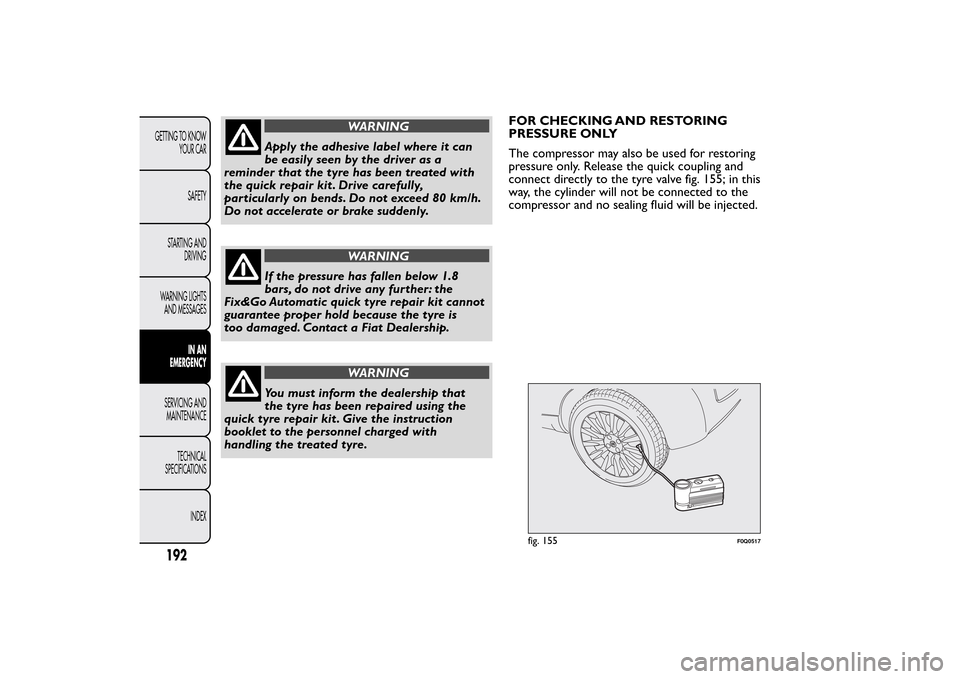
WARNING
Apply the adhesive label where it can
be easily seen by the driver as a
reminder that the tyre has been treated with
the quick repair kit . Drive carefully,
particularly on bends. Do not exceed 80 km/h.
Do not accelerate or brake suddenly.
WARNING
If the pressure has fallen below 1.8
bars, do not drive any further: the
Fix&Go Automatic quick tyre repair kit cannot
guarantee proper hold because the tyre is
too damaged. Contact a Fiat Dealership.
WARNING
You must inform the dealership that
the tyre has been repaired using the
quick tyre repair kit . Give the instruction
booklet to the personnel charged with
handling the treated tyre.FOR CHECKING AND RESTORING
PRESSURE ONLY
The compressor may also be used for restoring
pressure only. Release the quick coupling and
connect directly to the tyre valve fig. 155; in this
way, the cylinder will not be connected to the
compressor and no sealing fluid will be injected.
fig. 155
F0Q0517
192GETTING TO KNOW
YOUR CAR
SAFETY
STARTING AND
DRIVING
WARNING LIGHTS
AND MESSAGES
IN AN
EMERGENCY
SERVICING AND
MAINTENANCE
TECHNICAL
SPECIFICATIONS
INDEX
Page 197 of 299
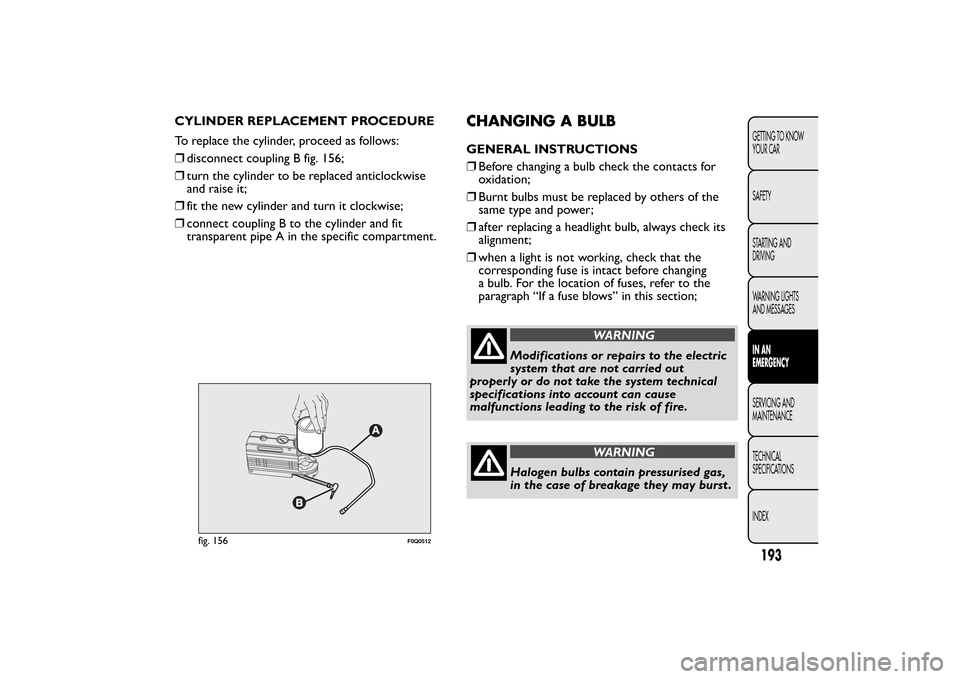
CHANGING A BULBGENERAL INSTRUCTIONS
❒Before changing a bulb check the contacts for
oxidation;
❒Burnt bulbs must be replaced by others of the
same type and power;
❒after replacing a headlight bulb, always check its
alignment;
❒when a light is not working, check that the
corresponding fuse is intact before changing
a bulb. For the location of fuses, refer to the
paragraph “If a fuse blows” in this section;
WARNING
Modifications or repairs to the electric
system that are not carried out
properly or do not take the system technical
specifications into account can cause
malfunctions leading to the risk of fire.
WARNING
Halogen bulbs contain pressurised gas,
in the case of breakage they may burst .
fig. 156
F0Q0512
193GETTING TO KNOW
YOUR CAR
SAFETY
STARTING AND
DRIVING
WARNING LIGHTS
AND MESSAGESIN AN
EMERGENCYSERVICING AND
MAINTENANCE
TECHNICAL
SPECIFICATIONS
INDEX
CYLINDER REPLACEMENT PROCEDURE
To replace the cylinder, proceed as follows:
❒disconnect coupling B fig. 156;
❒turn the cylinder to be replaced anticlockwise
and raise it;
❒fit the new cylinder and turn it clockwise;
❒connect coupling B to the cylinder and fit
transparent pipe A in the specific compartment.
Page 198 of 299
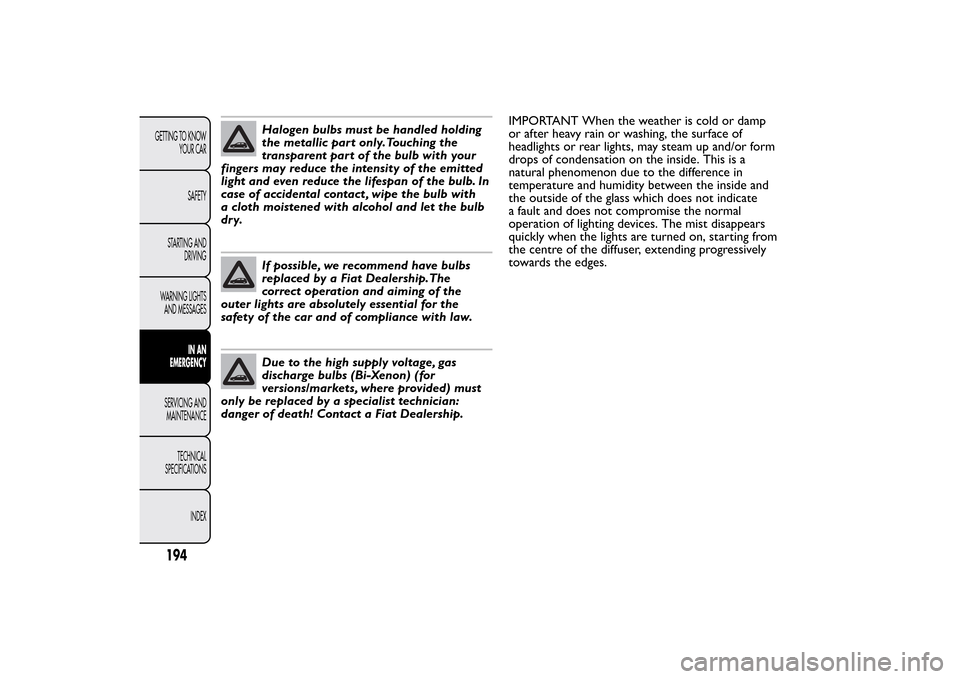
Halogen bulbs must be handled holding
the metallic part only.Touching the
transparent part of the bulb with your
fingers may reduce the intensity of the emitted
light and even reduce the lifespan of the bulb. In
case of accidental contact , wipe the bulb with
a cloth moistened with alcohol and let the bulb
dry.If possible, we recommend have bulbs
replaced by a Fiat Dealership.The
correct operation and aiming of the
outer lights are absolutely essential for the
safety of the car and of compliance with law.Due to the high supply voltage, gas
discharge bulbs (Bi-Xenon) (for
versions/markets, where provided) must
only be replaced by a specialist technician:
danger of death! Contact a Fiat Dealership.IMPORTANT When the weather is cold or damp
or after heavy rain or washing, the surface of
headlights or rear lights, may steam up and/or form
drops of condensation on the inside. This is a
natural phenomenon due to the difference in
temperature and humidity between the inside and
the outside of the glass which does not indicate
a fault and does not compromise the normal
operation of lighting devices. The mist disappears
quickly when the lights are turned on, starting from
the centre of the diffuser, extending progressively
towards the edges.
194GETTING TO KNOW
YOUR CAR
SAFETY
STARTING AND
DRIVING
WARNING LIGHTS
AND MESSAGES
IN AN
EMERGENCY
SERVICING AND
MAINTENANCE
TECHNICAL
SPECIFICATIONS
INDEX
Page 199 of 299
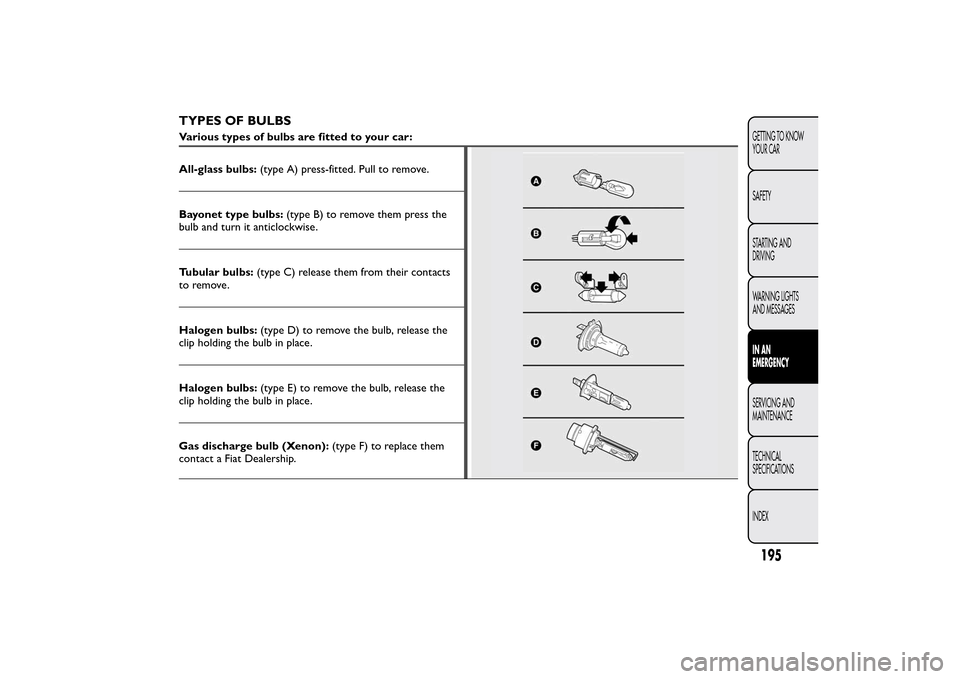
TYPES OF BULBSVarious types of bulbs are fitted to your car:
All-glass bulbs:(type A) press-fitted. Pull to remove.Bayonet type bulbs:(type B) to remove them press the
bulb and turn it anticlockwise.
Tubular bulbs:(type C) release them from their contacts
to remove.
Halogen bulbs:(type D) to remove the bulb, release the
clip holding the bulb in place.
Halogen bulbs:(type E) to remove the bulb, release the
clip holding the bulb in place.
Gas discharge bulb (Xenon):(type F) to replace them
contact a Fiat Dealership.
195GETTING TO KNOW
YOUR CAR
SAFETY
STARTING AND
DRIVING
WARNING LIGHTS
AND MESSAGESIN AN
EMERGENCYSERVICING AND
MAINTENANCE
TECHNICAL
SPECIFICATIONS
INDEX
Page 200 of 299
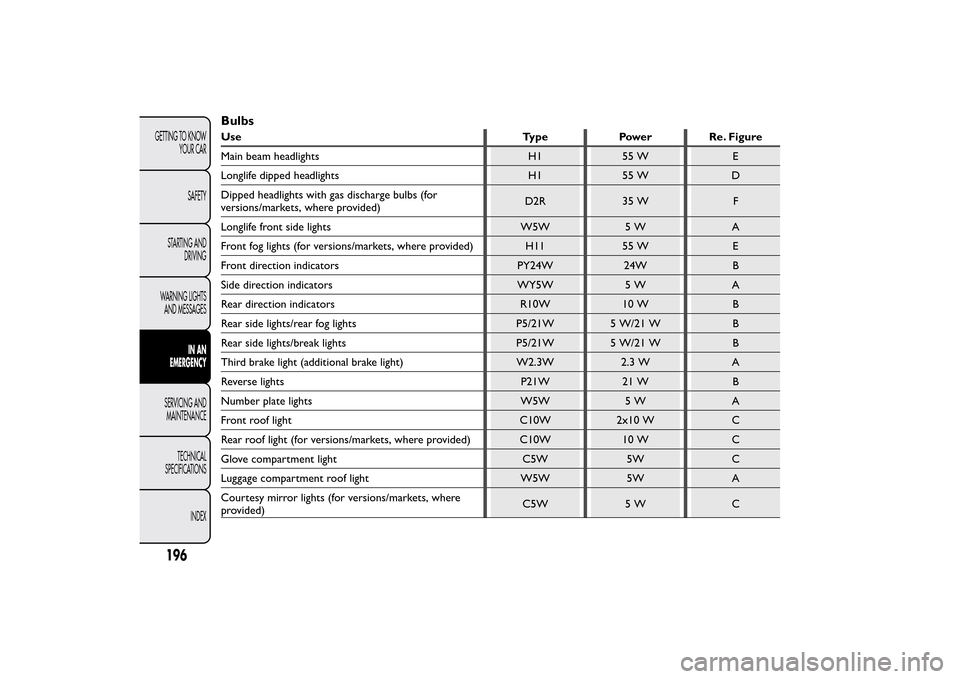
BulbsUse Type Power Re. Figure
Main beam headlights H1 55 W E
Longlife dipped headlights H1 55 W D
Dipped headlights with gas discharge bulbs (for
versions/markets, where provided)D2R 35 W F
Longlife front side lights W5W 5 W A
Front fog lights (for versions/markets, where provided) H11 55 W E
Front direction indicators PY24W 24W B
Side direction indicators WY5W 5 W A
Rear direction indicators R10W 10 W B
Rear side lights/rear fog lights P5/21W 5 W/21 W B
Rear side lights/break lights P5/21W 5 W/21 W B
Third brake light (additional brake light) W2.3W 2.3 W A
Reverse lights P21W 21 W B
Number plate lights W5W 5 W A
Front roof light C10W 2x10 W C
Rear roof light (for versions/markets, where provided) C10W 10 W C
Glove compartment light C5W 5W C
Luggage compartment roof light W5W 5W A
Courtesy mirror lights (for versions/markets, where
provided)C5W 5 W C
196GETTING TO KNOW
YOUR CAR
SAFETY
STARTING AND
DRIVING
WARNING LIGHTS
AND MESSAGES
IN AN
EMERGENCY
SERVICING AND
MAINTENANCE
TECHNICAL
SPECIFICATIONS
INDEX